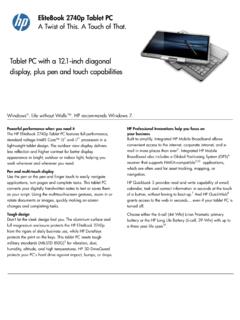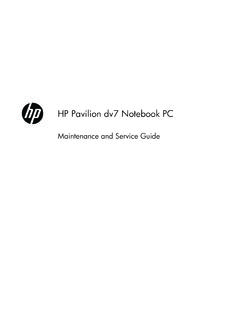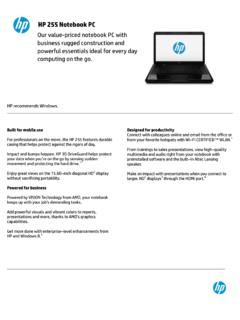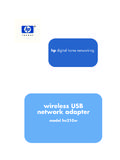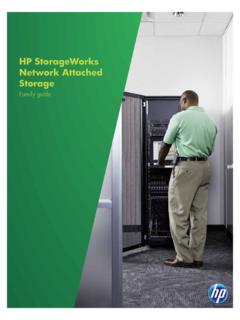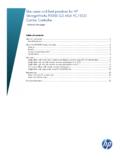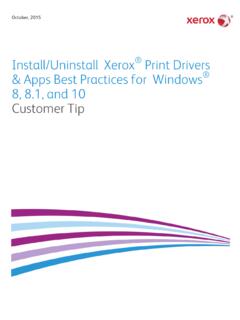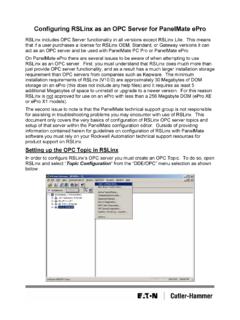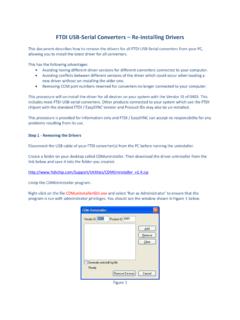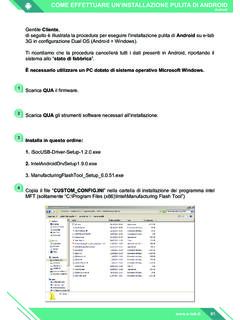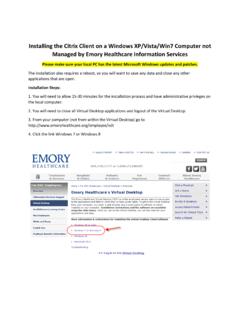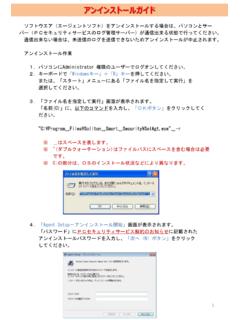Transcription of HP management software for Linux on ProLiant …
1 HP management software for Linux on ProLiant servers HOWTO, 6th Edition Text conventions ..3 HP Server management Drivers and Installing the drivers and Upgrading the drivers and 6 Running the drivers and Uninstalling the drivers and Custom builds and Rebuilding the hpasm package .. 8 Starting and stopping Health Driver System temperature monitoring .. 13 System fan Monitoring the system fault tolerant power ECC memory monitoring and advanced memory Automatic server HP Memory Hot Plug Console HP Integrated management Log Running the IML Accessing web-enabled ProLiant management Device Viewing subsystem and status Peer ProLiant management Agent configuration Data Collection Host OS Threshold Web Standard Equipment 23 System Health Troubleshooting ..24 HP Lights-Out Drivers and management Setup procedures ..29 Installing the drivers and Upgrading the drivers and Removing the drivers and 31 Configuring the HP ProLiant Rack Infrastructure Interface 32 Running the Removing the Using the HP ProLiant BL Rack Upgrade Storage Installing the Storage Upgrading the Storage Removing the Storage Storage Peer Storage Data Collection Agents.
2 38 IDA FCA IDE SCSI Event NIC Installing the NIC Upgrading the NIC Removing the NIC Using the NIC Agents ..41 Command line Systems Insight Rapid Deployment Troubleshooting ..43 For more Call to Abstract This HOWTO provides instructions for installing, upgrading, and removing management software , includes prerequisites for using this software with and without errata kernels, and contains usage information for each of the following management software products: HP Server management drivers and agents HP Lights-Out drivers and agents HP storage agents HP NIC agents Reference links to installation instructions for HP Systems Insight Manager and Rapid Deployment Pack are also provided. Text conventions This HOWTO uses the following conventions to distinguish elements of text: Menu options, Command names, Dialog box names, Screen names These elements appear in initial capital letters and may appear in boldface for emphasis.
3 User input (commands to be typed) User input appears in a different typeface and is highlighted in gray. Scripts and files The content of the scripts and files appears in a different typeface and is highlighted in gray with a border around it. Boldface text should be located on one line instead of on multiple lines as shown in the samples; formatting in this document prohibits correct usage. HP Server management Drivers and Agents The HP Server management Drivers and Agents (hpasm) replace the HP ProLiant Advanced Server management Driver (Health Driver). These drivers and agents collect and monitor important operational data on ProLiant servers. Contained within the hpasm package are the following: Advanced Server management Driver (Health Driver) Integrated management Log (IML) Viewer Application Foundation Agents Health Agent (formerly in the Server Agents package) Standard Equipment Agent (formerly in the Server Agents package) Server Peer Agent (formerly in the Server Agents package) ProLiant servers are equipped with hardware sensors and firmware to monitor certain abnormal conditions, such as abnormal temperature readings, fan failures, error correction coding (ECC) memory errors, etc.
4 The Health Driver monitors these conditions and reports them to the administrator by printing messages on the console (preserved in /var/log/messages) It also logs the condition to the ProLiant Integrated management Log (IML). The IML is dedicated Non-Volatile RAM (NVRAM) that can be viewed and maintained by the cpqimlview or hplog application. 3 The ProLiant management Agents are included to provide proactive notification of server events through the Systems Insight Manager console. Alternatively, the ProLiant management Agents allow the status of the server to be monitored or checked using a standard Web browser. Some ProLiant servers contain an Integrated Lights-Out (iLO) controller that, with optional software , allows secure remote management of the server including IML management and graphical remote console. For servers without the embedded iLO controller, similar functionality is available through an optional Remote Insight Lights-Out Edition (RILOE) or Remote Insight Lights-Out Edition II (RILOE II) adapter.
5 The Health Driver works in conjunction with the ProLiant management Agents to provide this support. Customers without automatic monitoring tools can check servers that have the ProLiant management Agents installed using a standard Web browser. The Web Agent responds to port 2381 (if the installed browser supports SSL encryption). For example, point the browser to :2381 or https://localhost:2381 (the "https://" portion of the address is required). There are also /proc file entries that allow making quick checks (see Table 1). Table 1. /proc descriptions File entry Description /proc/cpqtemp Shows the current temperature and the threshold levels of all temperature sensors. /proc/cpqfan Shows the status of all fans. /proc/cpqpwr Shows the status of all power supplies. Additional information about ProLiant management Agents is available at the following locations: Another source of information is the man pages included with the hpasm package: hpasm cpqimlview hpuid hplog These man pages include detailed information on error messages and possible action that the administrator may take.
6 Setup procedures The Server management Drivers and Agents are available as an RPM file. As with every RPM file, you may install, query, refresh, and uninstall the package. For the remainder of this section, we discuss how to install and uninstall the package. We also show you how the package should react during regular operation. 4 Prerequisites For the Web Agent to work properly, you must install the required library or package for the Linux distribution (see Table 2). Table 2. Web Agent requirements Linux distribution Required library or package Red Hat Linux distributions compat-libstdc++ library SUSE Linux Enterprise Server 7 and gppshare UnitedLinux package For full functionality, the Web Agent also requires the following: SNMP stack Version Java Virtual Machine or greater Note The recommended SNMP stack is the UC-Davis SNMP stack provided on the HP Linux website ( ).
7 The Stack provided by HP includes the extensions needed by the HP agents. Installing the drivers and agents 1. You must uninstall previous versions of the hpasm package before installing the new RPM file. See the "Uninstalling the drivers and agents" section for information on removing the drivers and agents. If concurrent access on the RPM database is attempted, the following messages may result: rpmQuery: rpmdbOpen() failed cannot get shared lock on database rpmQuery: rpmdbOpen() failed 2. Some of the ProLiant management Agents for Linux use RPM to query loaded software packages. Before attempting RPM maintenance, HP recommends terminating the agents with / stop and ensuring that only one root shell exists. 3. After obtaining the RPM file, login as the "root" user and type the following to install the drivers and agents: rpm ivh hpasm-<version>.<distribution>. Note The version number for the RPM file depends on the supported systems and functionality.
8 The distribution refers to the Linux distribution supported by the RPM. The RPM file has a binary compiled for the supported distribution with the default kernel. 4. To install or create the RPM for a non-default kernel, install the kernel sources for the compiled kernel. In addition, the development packages required for rebuilding a kernel may need to be present. 5 5. During the installation process, provide basic Simple Network Protocol (SNMP) information, when prompted. The recommended SNMP stack is the UC-Davis SNMP stack provided on the HP Linux website ( ). This stack is required to have full management support. The drivers and agents will be inserted immediately. On systems with variable speed fans, you may notice that the fans will start spinning more slowly if the temperature is reasonably low. 6. To check if the driver is loaded properly, type the following command (which is only available when logged in as "system administrator", super user , or "root"): lsmod You should see an entry indication that two drivers have been inserted: cpqasm and cpqevt.
9 The cpqasm and the cpqevt drivers should have a use count of 20 and 2, respectively, with the cpqevt driver showing a dependency on the cpqasm driver. 7. To check if the agents are loaded properly, type the following: ps ef | grep cma You should see an entry indication that the following agents are running: cmafdtnpeerd, cmahostd, cmathreshd, cmawebd, cmasvrpeerd, cmastdeqd, and cmahealthd. Upgrading the drivers and agents RPM provides the option to upgrade a package. 1. Before upgrading, uninstall any RPM packages that are dependent on the hpasm package, such as the Lights-Out Drivers and Agents, the Storage Agents, and the NIC Agents, since these packages are dependent upon a specific hpasm package version. Important Attempting to install these packages on an unsupported hpasm package version might result in an unstable system. 2. To uninstall any packages present on the server, type the following, in exact order: rpm -e cmanic rpm -e cmastor rpm -e cmasvr rpm -e cmafdtn rpm -e cpqriis rpm -e cpqci rpm -e cpqrid rpm -e hprsm 3.
10 To upgrade the hpasm package, type the following command: rpm -Uvh hpasm-<version>.<distribution>. If the upgrade option is used, the hpasm package will stop after installation to preserve system stability to allow the user to upgrade any components dependent upon the hpasm package (for example, hprsm, cmastor, and cmanic). You cannot upgrade the cpqhealth package. You must remove the previous version (rpm e cpqhealth) before installing the newer version of hpasm. You can use the upgrade command shown above to install the hpasm package. 6 After installing the package, the agents do not start immediately. Instead, the following message should appear on the terminal: NOTE: In order to activate the software contained in this package, you must type hpasm activate as the "root" user. After typing % hpasm activate, the software guides you through various questions which relate to the way SNMP should be configured with the ProLiant management Agents.
